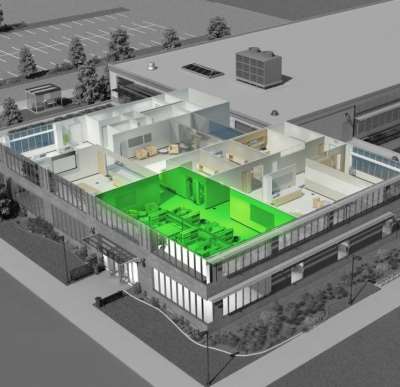Support areas provide space for documentation assembly and storage. Provide multi-use equipment for fax, copy and scanning abilities. Use signage to educate building occupants regarding sustainably. Provide accessible collection bins to recycle toner cartridges, batteries, cardboard, paper, etc. Negatively pressurize spaces to remove any fumes associated with high volume printers or copiers. View Planning Strategies
Interested in Support Area-related products?
View related green products and services on the Green Procurement Compilation- Copy Room Equipment
-
Copy Room Equipment
- Look for units that have energy-saving cycles or that will automatically power down when not in use. Similarly, consider putting non-essential equipment on timers to power down during non-business hours.
Click Design Guidance to View Additional Best Practices
- Recycling Support
-
Recycling Support
- Provide well labeled recycle, compost and trash containers in common areas.
- Educate occupants and janitorial staff to encourage participation and reduced contamination.
- Work with waste and recycling vendor to ensure compliance with current requirements.
Click Design Guidance to View Additional Best Practices
- Lighting
-
Lighting
- Use daylight sensor controls that turn off electric lighting in response to natural light levels to reduce energy consumption. When used in combination with occupant sensors, a sustainable lighting control program can have significant benefits.
- Use efficient LED lamps as they use less energy, do not give off as much heat as incandescent bulbs, and have a longer useful life.
- Use sustainable lighting practices such as occupant sensors to decrease utility costs.
Click Design Guidance to View Additional Best Practices
- Flooring
-
Flooring
- Evaluate sustainable attributes such as high recycled content and low VOC's to determine the most appropriate sustainable product for the space. Remember that adhesives may be required for flooring, and these may add VOC's even if the finish flooring does not.
- Prevent stains by cleaning up spills promptly, starting with cold water and blotting cloths.
- Select durable and easy to clean floor surfaces such as rubber, tile, or linoleum as break rooms and support areas are prone to high traffic and frequent spills.
Click Design Guidance to View Additional Best Practices
- HVAC
-
HVAC
- Install occupant control thermostats that have prescribed temperature range limits to promote occupant comfort.
- Ensure the air supplied by the HVAC system is properly conditioned - providing comfortable temperature ranges, removing moisture and air contaminants such as odors, dust, and carbon dioxide. Proximity to an exterior wall should be evaluated to minimize ductwork.
- Ensure the minimum level, or higher, of outside air is circulated within occupied spaces to increase indoor air quality.
Click Design Guidance to View Additional Best Practices
- Advanced Power Strip (APS)
-
Advanced Power Strip (APS)
- Manage plug loads by utilizing advanced power strips (APSs) and plug load control strategies applicable to the space's specific equipment and use.
- Educate occupants on the importance of plug load management, and assist them in understanding the technologies and strategies being implemented.
- Explore SFTool's Plug Load content to discover what you can do to limit the unnecessary energy use of plug loads.
Click Design Guidance to View Additional Best Practices
- Ceiling
-
Ceiling
- Use acoustical ceiling tiles with high Noise Reduction Coefficients (NRC) to reduce noise pollution and allow for ease of access to the plenum space for maintenance.
- Use light-colored ceiling tiles to reflect daylight to allow natural light to effectively move throughout the space.
- Evaluate sustainable attributes such as regional manufacturing, recycled content, and low VOC to determine the most appropriate materials to use for a sustainable ceiling.
Click Design Guidance to View Additional Best Practices
- Walls
-
Walls
- Use wall space in a copy room to educate employees on sustainability.
- Change signage regularly to stimulate interest.
- Consider replacing part of the standard wall with interior glazing to allow natural light to penetrate into the interior space.
Click Design Guidance to View Additional Best Practices
- Recycling Support
-
Recycling Support
- Provide well labeled recycle, compost and trash containers in common areas.
- Educate occupants and janitorial staff to encourage participation and reduced contamination.
- Work with waste and recycling vendor to ensure compliance with current requirements.
Click Design Guidance to View Additional Best Practices
- Copy Room Equipment
-
Copy Room Equipment
- Look for units that have energy-saving cycles or that will automatically power down when not in use. Similarly, consider putting non-essential equipment on timers to power down during non-business hours.
Click Design Guidance to View Additional Best Practices
- Flooring
-
Flooring
- Evaluate sustainable attributes such as high recycled content and low VOC's to determine the most appropriate sustainable product for the space. Remember that adhesives may be required for flooring, and these may add VOC's even if the finish flooring does not.
- Prevent stains by cleaning up spills promptly, starting with cold water and blotting cloths.
- Select durable and easy to clean floor surfaces such as rubber, tile, or linoleum as break rooms and support areas are prone to high traffic and frequent spills.
Click Design Guidance to View Additional Best Practices
- Lighting
-
Lighting
- Use daylight sensor controls that turn off electric lighting in response to natural light levels to reduce energy consumption. When used in combination with occupant sensors, a sustainable lighting control program can have significant benefits.
- Use efficient LED lamps as they use less energy, do not give off as much heat as incandescent bulbs, and have a longer useful life.
- Use sustainable lighting practices such as occupant sensors to decrease utility costs.
Click Design Guidance to View Additional Best Practices
- HVAC
-
HVAC
- Install occupant control thermostats that have prescribed temperature range limits to promote occupant comfort.
- Ensure the air supplied by the HVAC system is properly conditioned - providing comfortable temperature ranges, removing moisture and air contaminants such as odors, dust, and carbon dioxide. Proximity to an exterior wall should be evaluated to minimize ductwork.
- Ensure the minimum level, or higher, of outside air is circulated within occupied spaces to increase indoor air quality.
Click Design Guidance to View Additional Best Practices
- Ceiling
-
Ceiling
- Use acoustical ceiling tiles with high Noise Reduction Coefficients (NRC) to reduce noise pollution and allow for ease of access to the plenum space for maintenance.
- Use light-colored ceiling tiles to reflect daylight to allow natural light to effectively move throughout the space.
- Evaluate sustainable attributes such as regional manufacturing, recycled content, and low VOC to determine the most appropriate materials to use for a sustainable ceiling.
Click Design Guidance to View Additional Best Practices
- Walls
-
Walls
- Use wall space in a copy room to educate employees on sustainability.
- Change signage regularly to stimulate interest.
- Consider replacing part of the standard wall with interior glazing to allow natural light to penetrate into the interior space.
Click Design Guidance to View Additional Best Practices





